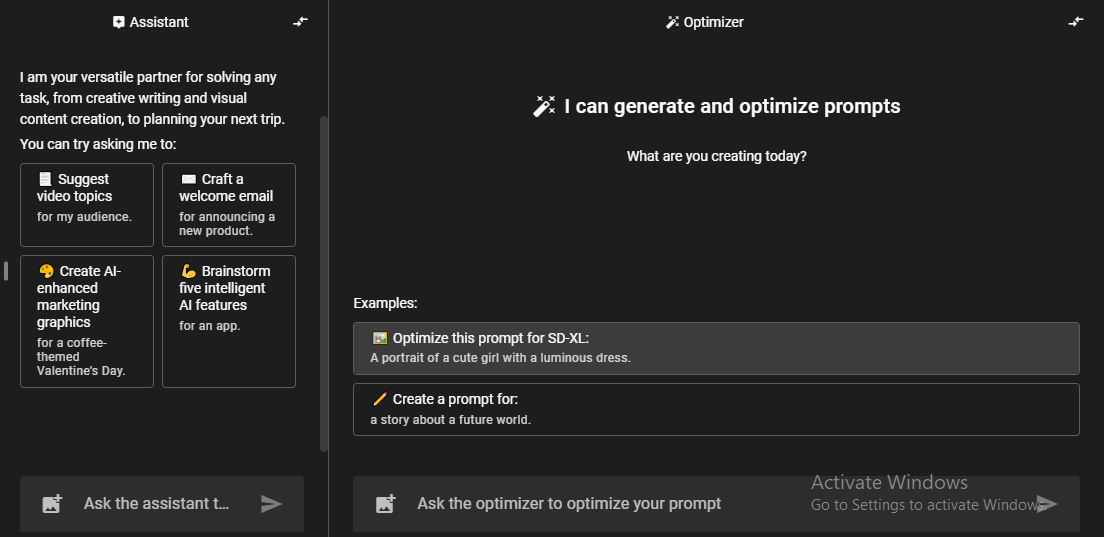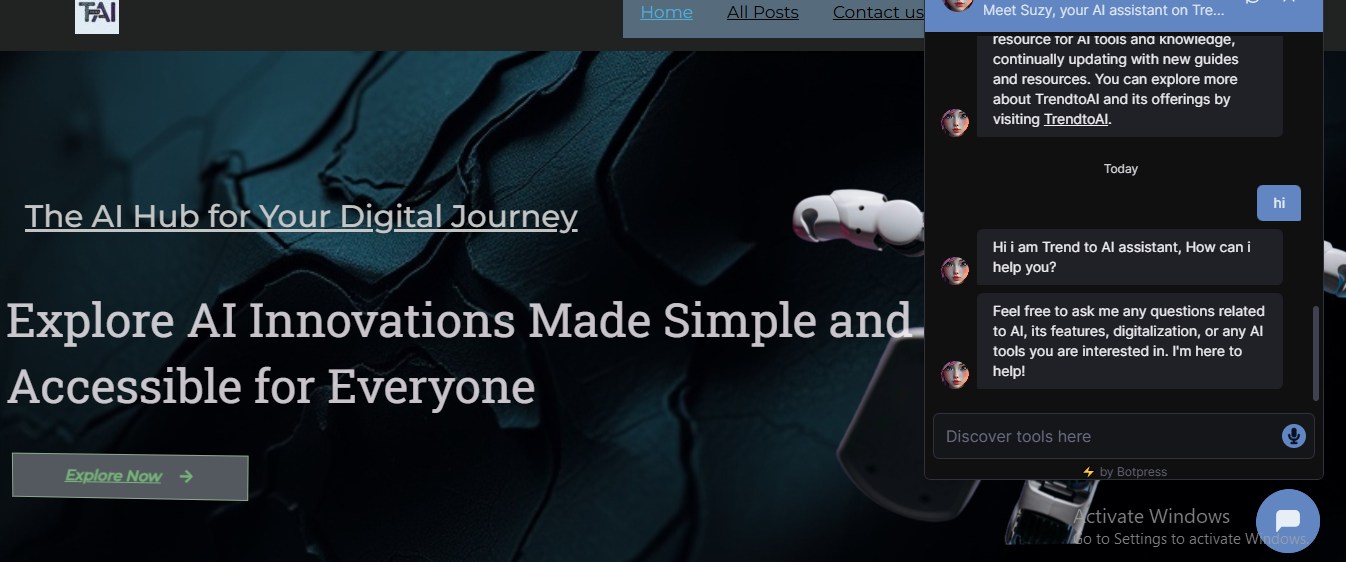Introduction
Recent developments in AI have seen a surge of AI tools that use natural language interfaces to interact with the user, including chatbots. User-input-guided chatbots are also well known as command-based chatbots, or “commanding AI tools,” wherein the user supplies the input as a “prompt” command, which defines the desired response by referencing the task and its characteristics.
The current task of crafting an effective prompt that commands complex AI tools requires much skill and effort, and the challenge is largely unexamined by prior work. Simple prompt modifications suggested by studies often lead to limited improvement. Without a good way to facilitate the creation of high-quality prompts, democratizing these tools can be difficult, as their naive usage might lead to conflicting results and unintended biases.
Our aim in the present study is to analyze the role of prompts in the output of the AI tools and the usage of the tools by the users, when the interaction between them starts fresh or from a rebooted state. This could happen either when a user first starts using a tool or after not having used it for a long time.
We consider two fairly disparate command-based AI tools for text content generation, with important differences between the training data, learning algorithm, and architecture, both in an underlying model and using different machine learning models. In that spirit, we’ve followed a citizen science approach by experimenting with several leading chatbots to investigate the effects of prompts.
We explored factors of a filtered language model through a case study by gathering and analyzing a set of user prompts collected by volunteers from an online crowdsourcing platform. Another possible command-based AI tool is treated by applying the standard technique for the analysis of data on the training distribution. Our work brings out some factors that might contribute quite effectively to better prompts and also some conjectures.
Some of the major contributions of our paper lie in the design and implementation of the study to collect and analyze the relevant chat data for the functioning of chatbots and an analysis of what difference is being made that led to other top-notch chatbots. Further, our findings add further value to the community in learning about the development and deployment of chatbots.
Definition of AI Tools
AI designates systems that can, for a given range of tasks, improve their performance behavior through learning from data. Two characteristics, nonlinearity, and flexibility represent two primary features of AI tools that distinguish them from other more traditional analytics tools: their explicit command to compute or their automatic generation of sequences of parameters that greatly influence the decision-making at hand.
Such a sequence is commonly referred to as a “rule set” or “model.” The model is then used to generate the output of interest, which will include the new information pertinent to the decision-making, apart from the actual level of complexity of the decision-maker. AI systems can meet both these design objectives only if the command issued is well-defined and articulated. This command is often expressed in the form of a prompt. Good prompts are important for successful command.
Apt prompts help greatly in the successful application of an AI tool. Indeed, feedback in general is part of the dynamics involved in the application of AI tools. Yet, the back-and-forth can and should start even before model construction begins.

Typically it starts with constructing an apt and effective prompt. The utility and appropriateness of the command set and the degree of cooperation of experts in various sectors in a rational decision model should be determined to ascertain its structure, complexity, and parameter estimates.
This is fundamental in choosing viable modeling tools. In AI systems, typically, the command is given as a query. Model building performances depend to a great extent on the design and form of queries presented to the AI model. In projects that involve a decision-making team, it is especially in the quality of such communication aids that such differences matter.
The worth of the model depends on the interaction between AI and its human/firm taskmaster. The prompt plays a pivotal role in a chain of activities that lead to the right AI work. It should guide the AI so that it functions better.
Understanding User Needs
The process of effective prompts is therefore first knowing what the user requires and what they need. The user may want something fast and straightforward, or the user may want something more complicated and creative. Knowing exactly what the user expects from the AI tool ensures that the prompts are set so that the output they produce meets the requirements.
Identifying User Goals
Understand first what the user is trying to accomplish before creating a prompt. Do they need some quick, factual information, or are they looking for something more creative and complex, like a story or an artwork personalized just for them? Knowing that will determine whether it has to be very specific or rather general.
For instance, if the user’s objective is to create content, then an AI tool will write a blog post on a specific topic such as video story generation. In this case, the prompt would need to include the type of content it has to be, whether it should be informative, persuasive, or casual, the tone, and possibly the word count.
For art, the prompt could be more about visual aspects, such as style, color palette, and subject matter. First, identifying the goals ensures that the prompt is designed to produce the right results.

Principles for Prompt Design
When the user needs have been defined, then there is a need to design a prompt which means it should be clear and well-structured. Also, the prompt is supposed to be concise. Very important while designing the prompt is for one to ensure the AI-produced result is correct.
Clarity and Simplicity
It must be simple and clear. The way a prompt is interpreted by the AI tools is by breaking down the parts that they can process. If it’s too complicated or vague, the AI would not be able to come up with the intended result. Make sure that the prompt is simple, using simple words with clear language. Do not use ambiguous words; otherwise, the output will not be correct or irrelevant.
For example:
Compare two of these prompts:
• Bad Prompt: “Write an interesting article about technology.”
• Best Prompt: Write a 500-word Essay: Consequences of the Effects AI Has on Medicine Healthcare Nowadays and Its Prospects for Development.
The second prompt is more specific, which helps guide the AI in generating relevant and focused content. By specifying the topic (AI’s impact on healthcare), length (500 words), and key focus areas (current trends and future possibilities), the prompt is designed to ensure the output aligns with the user’s expectations.
Types of Prompts
The kind of prompts differs based on the task to be done. What improves the output of AI are the different kinds of prompts and when to use them.
Text-based prompts
Among all input categories for AI tools, texts are probably the most abundant. They can create an infinite variety of stuff such as blog entries, stories, social content, code, and also reports. The quantity and degree of detail provided also reflect the complexity level that such input must possess. Prompts then can vary from basic to elaborate questions and statements.
For example:
A text-based prompt to use an AI art generator could be:
• Bright color abstract painting on geometric shapes with a futuristic theme.
Here, the prompt contains specific instructions on the desired style (abstract), color palette (vibrant colors), and themes (geometric shapes, futuristic). This will help the AI to understand the aesthetic and produce an image relevant to the prompt.
Best Practices for Prompts
Now that we have covered the elementary principles and varieties of prompts, let’s discuss some of the best practices that help you to prepare more effective prompts:
Use of Natural Language
Everyday natural-language phrases can be one of the simplest and very basic skills or techniques applied to creating good-quality prompts. Even though AI systems receive very structured commands, conversing in natural language generally offers more accurate and meaningful results since it gets to comprehend much more by following even the simplest elements of natural language usage, such as phrase and sentence structure. When you frame your prompts, then they are more likely to happen like you would normally speak and write.
For example:
• Too Formal Prompt: “Write a blog post: AI in healthcare.”
• Natural, Conversational Prompt: Blog post on how artificial intelligence is impacting healthcare and ways in which it could help patient care.
The second request, rather flowing about context, guides the algorithm to create a fuller blog on the topic by providing contextual information.
Effectiveness of Prompt
Once you have designed your prompt and the AI has provided the output, it is time to evaluate whether the prompt worked well. Was the output what you wanted? Did it meet your objectives? The effectiveness of your prompt is something that you continually evaluate as you refine and improve future prompts.
User Testing and Feedback
One of the best ways to judge how effective prompts are would be through testing on users. Through this approach, you gather feedback from those who use the AI content generated. Were they helped? Was the answer accurate to what they required? This serves to enable one to rate whether the AI has correctly grasped your intent in that prompt and whether or not what was returned fulfilled the users’ needs.
For instance:
You can ask the user if the output of applying a prompt to generate content was useful or if some of the necessary information was left out. Your answers can assist in tailoring your prompts toward producing better future results.
Case Studies
Real case studies are a good source of learning as to how effective prompt designs result in successful outcomes. Case studies enable us to learn how specific prompt structures were used to achieve the desired results.
7.1. Successful Prompt Designs
In this section, we will examine several case studies of successful prompt designs across a range of AI tools. Analyzing the cases enables us to uncover the key elements of effective prompts.
For example:
A case study on an AI art generation tool may include the fact that one user provided very specific color schemes, artistic styles, and themes to be incorporated into the piece. It resulted in a visually spectacular piece of artwork that captured the user’s vision perfectly.
Similarly, an AI writing assistant might have been given a prompt with specific guidelines about tone, structure, and target audience, which resulted in a well-structured, engaging article that met the client’s needs.
Exploring Prompthero.com: An AI Tool for Generating Prompts
AI tools have changed the way we interact with technology, from the generation of text to the generation of images and even entire websites. Amongst the AI-generated prompts that stand out is Prompthero.com.
This treasure trove of prompts provides its users with an enormous categorized library of inputs for the most creative and functional purposes imaginable. Whether you’re trying to write text content, design digital art, or discover new AI possibilities, Prompthero.com is an excellent resource that can guide you through it all.
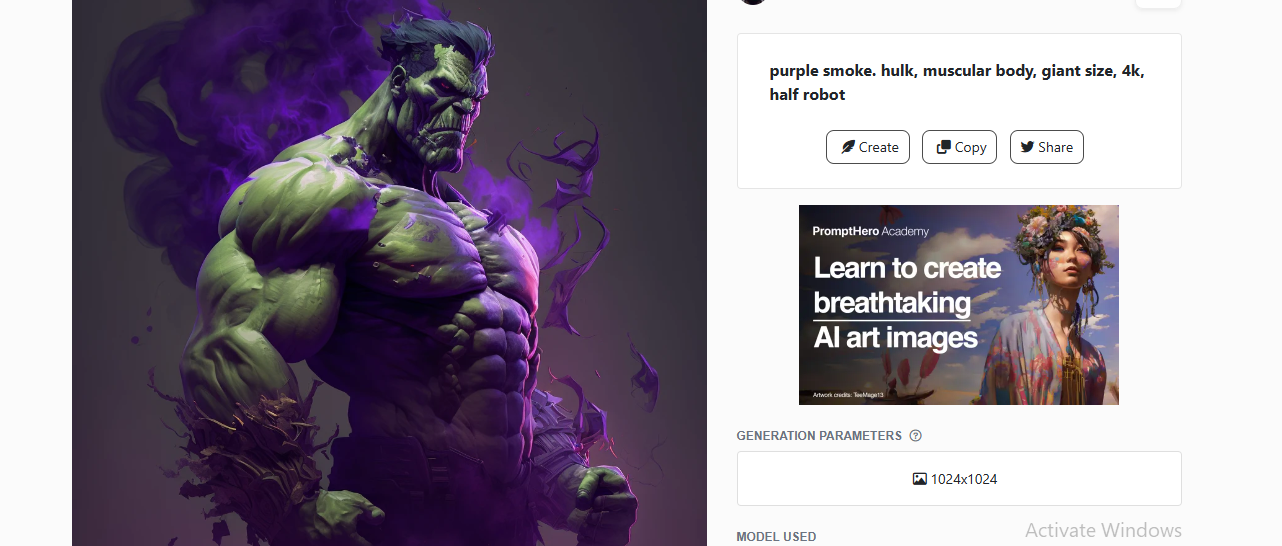
What is Prompthero.com?
Prompthero.com is an online platform designed to give users an extended array of ready-made prompts usable with other AI tools. These prompts are the prepared text inputs, adapted and prepared for work with the help of the various kinds of AI tools, like creating images or generating content and so much more.
Without spending extra time writing their prompts, people can browse and just copy the ones ready, according to their needs, for further pasting.
The website features an intuitive interface that organizes prompts into categories, making it easier for users to find what they need based on their specific goals and the AI tools they are using. Whether you’re a beginner looking to experiment with AI tools or a professional seeking to streamline your creative process, Prompthero.com offers something for everyone.
Categories of Prompts Available on Prompthero.com
The diversity in the topics it addresses is perhaps the most salient feature of Prompthero.com. The website categorizes its prompts into several sections that are dedicated to a particular area of AI tool use. Some of the most popular categories include:
1. Featured:
These are the top-rated prompts, either handpicked by the Prompthero team or selected from the user community. Such prompts have been tested and yielded quality results.
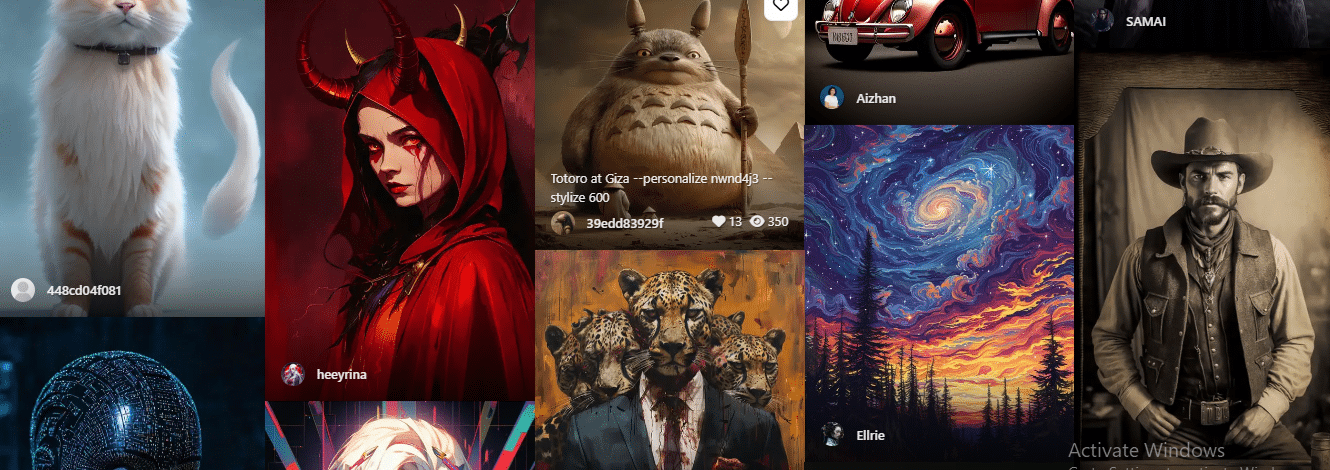
2. Trending:
This is the “Hot” section, featuring the newest and most trending prompts. These are the most popular among users, hence providing fresh inspiration.
3. New:
As the name says, it is the section of newly added prompts on the platform. It is a great choice for users who want to be on top of trends or just try something new.

4. Top:
The “Top” category holds the most recommended prompts on the site. These prompts have been used and rated by many users, making them a reliable choice for generating results.
5. FLUX:
This category focuses on the FLUX tool, which is known for generating unique and artistic outputs. Prompts under this category are crafted to work specifically with FLUX’s capabilities.

6. ChatGPT:
ChatGPT is one of the most widely used AI tools, and therefore, its prompts are highly in demand. This category offers prompts tailored for text generation, conversation, and other language-based work.
7. Midjourney:
Midjourney is a highly potent image-generating AI, and this category features prompts specifically designed to work with this tool. Users can create everything from abstract art to realistic landscapes with Midjourney prompts.

8. Portraits:
If you are interested in portraiture, detailed and more lifelike, here are the prompts for portraits for AI portrait-generation purposes. If you are digitizing a person or just creating a character, check this section out-it has countless options.

9. Photography:
If it is photorealistic images or inspirational photography, this category is intended for you. These suggestions will help you create that perfect image that a professional photographer will take.
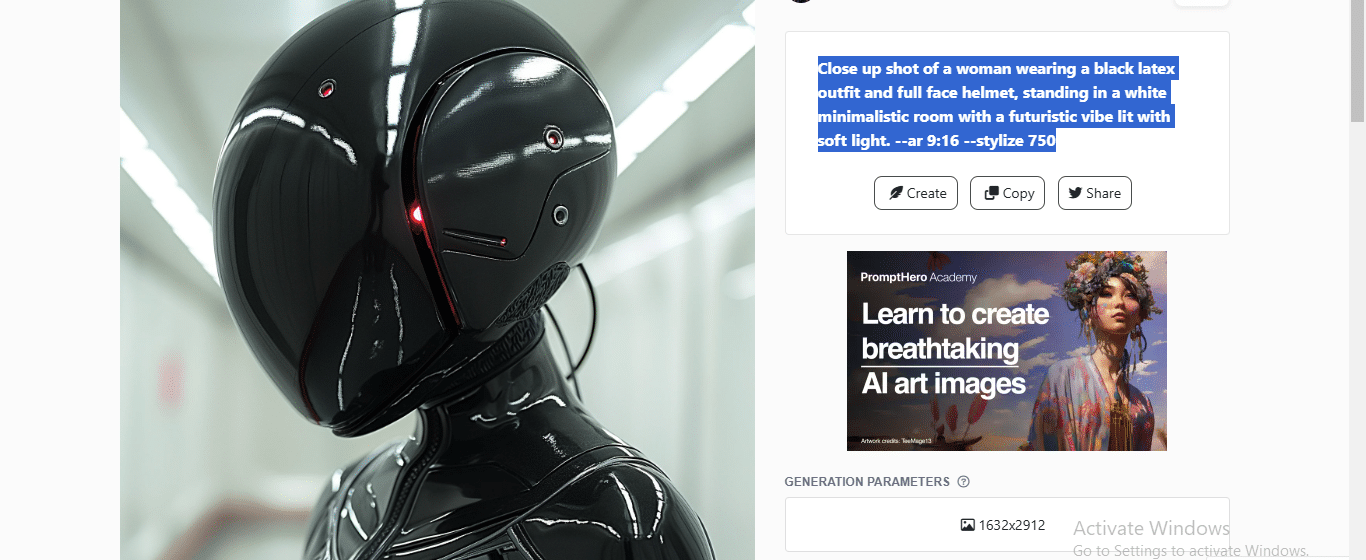
10. Anime:
The Anime category allows fans of anime or the user looking to create art in the style of anime. Prompts will be related to the character, scene, and setting in the signature style of anime.

11. Fashion:
Fashion lovers can look for prompts related to the generation of designs of fashion, clothing styles, and even digital runways.
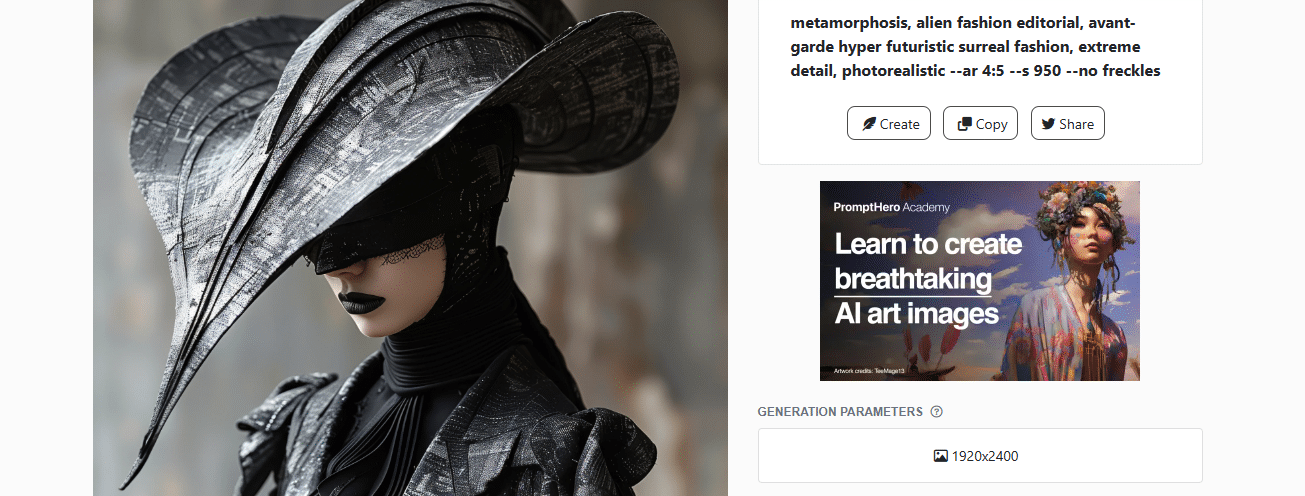
12. Concept Art:
It has Concept Art prompts that you can use when working on a video game, movie, or graphic novel for original ideas about characters and their environments, as well as other forms of artistic works.
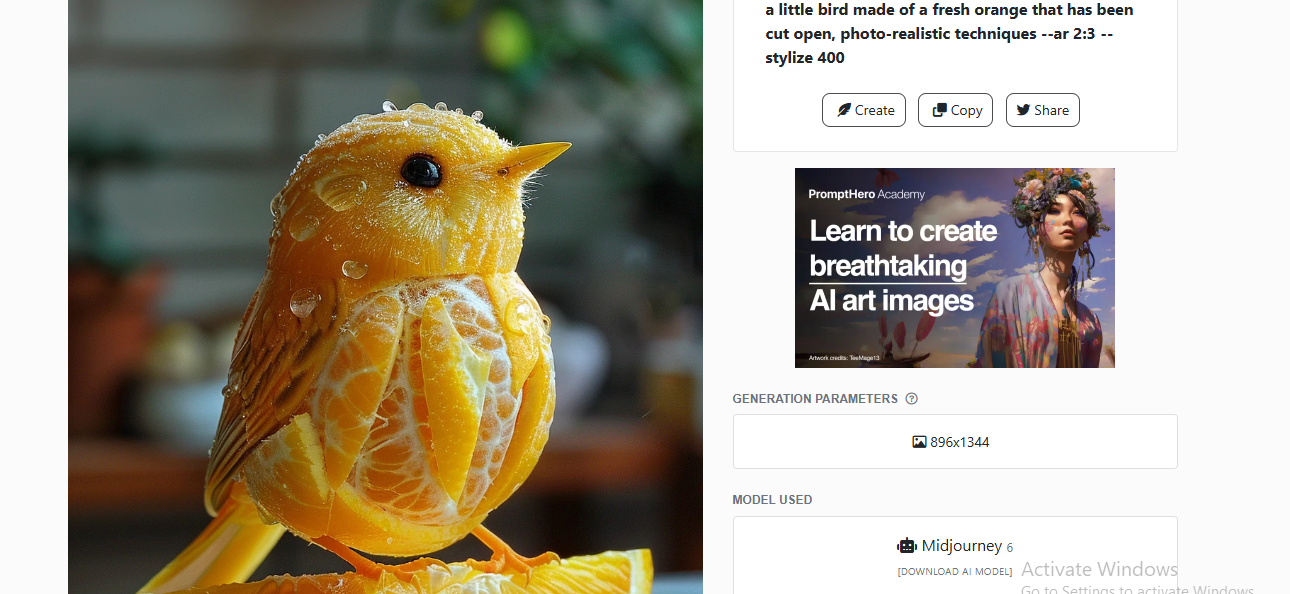
13. Architecture:
Architecture contains prompts that you can use to generate designs of buildings, architectural styles, and urban landscapes.
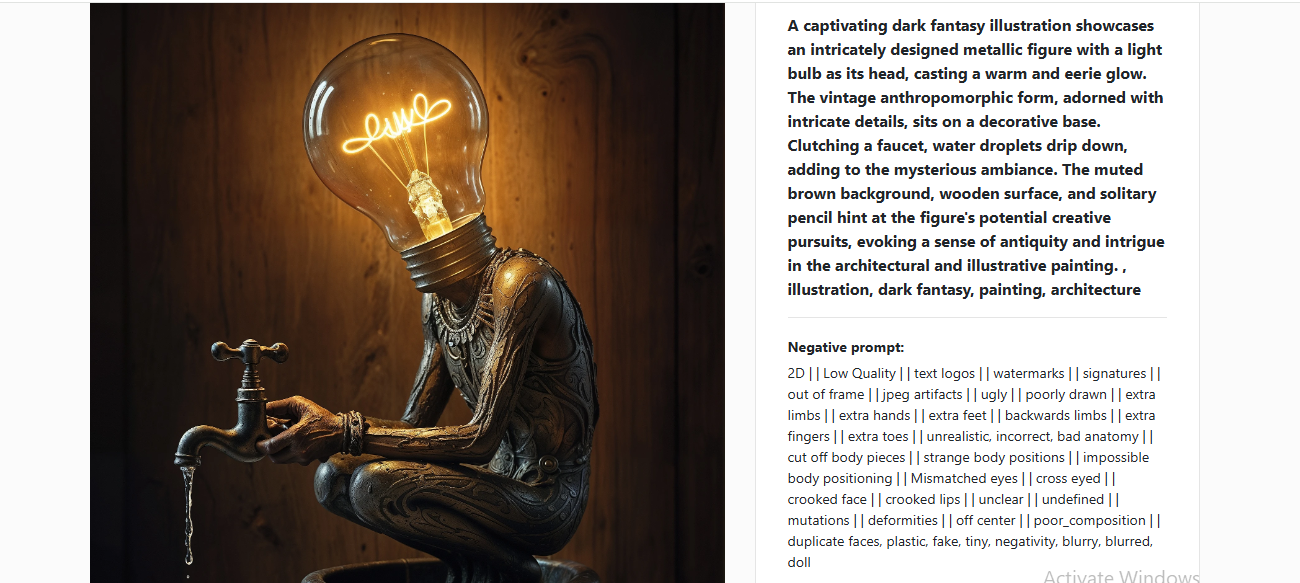
14. Landscapes:
To create beautiful natural sceneries ranging from serene beaches to majestic mountains, there are many prompts in the Landscapes category for creating outstanding environmental art.

15. Logos, Icons & Design:
The prompts in this category are mostly for graphic design, assisting the user in generating ideas about logos, icons, and other designs.
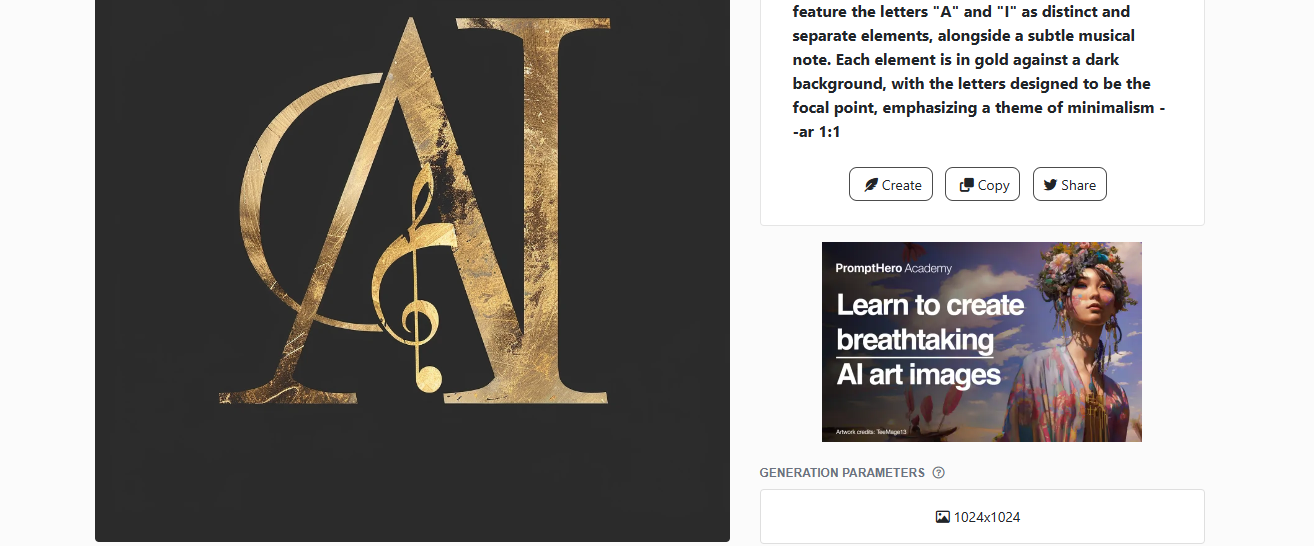
16. Interior Design:
For interior design projects, the prompts here can help a user generate ideas about the home layout, decor, and furniture arrangement.

17. 3D / Renders:
In this category, the user is interested in 3D modeling and rendering. The prompts provided are more specific to generating ideas on 3D objects, environments, and designs.
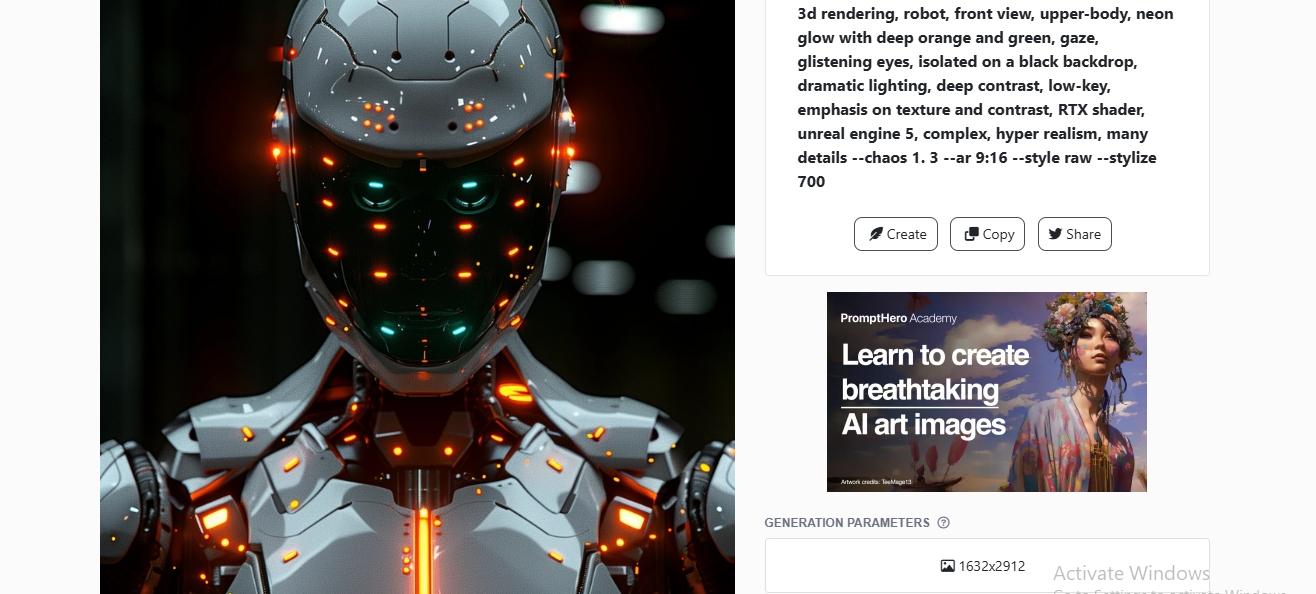
18. Character Design:
Whether you’re designing characters for a game, comic, or animation, this category provides prompts that help create unique and imaginative characters.
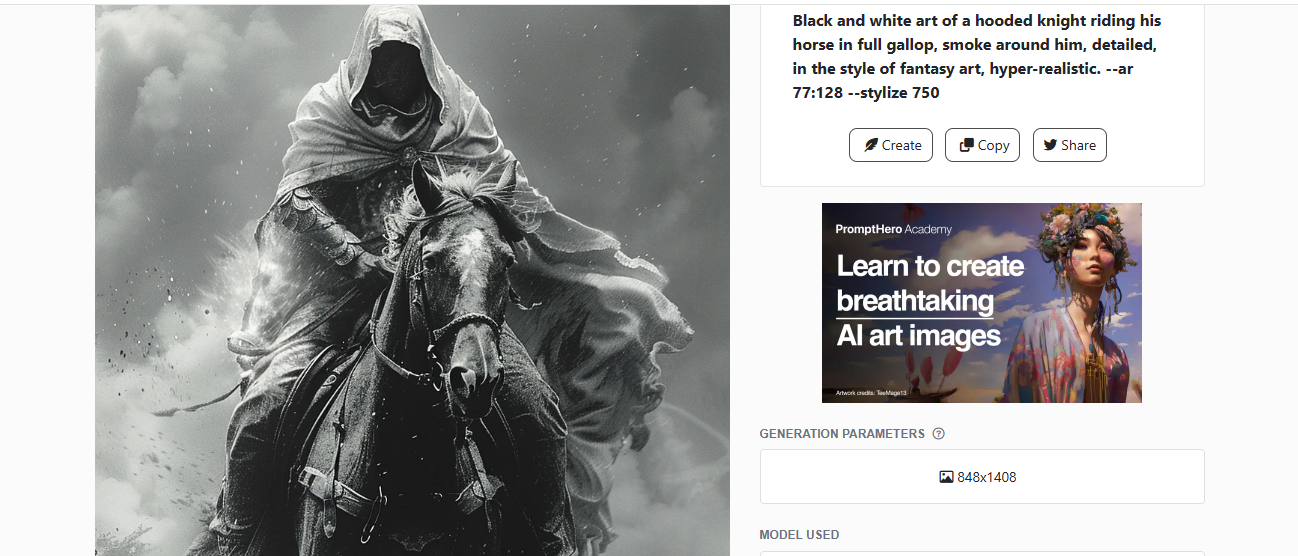
Special Categories for Advanced Users
Prompthero.com also includes several advanced prompt categories, ideal for users looking for highly specialized results or seeking to push the boundaries of what AI tools can do. These categories include:
1. Best AI Prompts:
It contains the best prompts based on their performance for high-quality, diverse, and creative output.
photography, a long hallway submerged under a calm ocean, walls and ceiling in a vibrant turquoise color, the surface of the water creating a wavy light pattern on the floor, the hallway lit by embedded small white lights, a modern and tranquil underwater architecture, photorealism
2. Best FLUX Prompts:
These prompts are exclusively prepared for FLUX use and can be utilized as the best for strikingly beautiful and dynamic output generation.
Shadowrun Math Projection – A close-up of a person’s face with set logical ambient background, DayGlo black gold holographic equations projected Crisis Point their skin. The background is Ghost and [Egyptian|Folk], with the equations appearing Cinestill and ever-changing, creating a World of Warcraft and perfect symmetry mood detail maximizer, midjourneyv6.1, bronze object, secretlab.
3. Best Ideogram Prompts:
An ideogram is a tool that specializes in generating illustrations and images based on concepts. The prompts here focus on visualizing abstract ideas and concepts in artistic ways.
a beautiful bohemian girl, intricate, highly detailed, digital painting, pixiv, artstation, official media, anime key visual, rich vivid colors, ambient lighting, sharp focus, illustration, art by wlop an intelligent young women looking at the camera, she has a beautiful unconventional face, she is surrounded by an explosion of 3D flowers, elegant, highly detailed, digital painting, artstation,, concept art, pop, smooth, sharp focus, illustration.
4. Best Stable Diffusion Prompts:
In the list, this is for those Stable Diffusion users. They contain prompts intended to provide stable, high-quality images and detail.
a delicate apple made of opal hung on branch in the early morning light, adorned with glistening dewdrops. in the background beautiful valleys, divine iridescent glowing, opalescent textures, volumetric light, ethereal, sparkling, light inside body, bioluminescence, studio photo, highly detailed, sharp focus, photorealism, photorealism, 8k, best quality, ultra detail:1.2, hyper detail, hdr, hyper detail.
5. Best Dream Shaper Prompts:
The next on this list is the Dream Shaper. The prompts were aimed at creating surreal or fantastic visual effects using this tool.
(fantasy horror excellence:1. 3), (premium artistry:1. 1), concept art, 8K UHD resolution, (nightmarish being:1. 3), (elegantly terrifying:1. 25), (sublime horror:1. 2), twisted horns, (intricate details:1. 2), (glistening scales:1. 1), (haunting gaze:1. 2), (ominous shadows:1. 15), foreboding background, (rich color palette:1. 2), (masterful monstrosity:1. 3)
6. Best Majic MIX Realistic Prompts:
These prompts are ideal for users who want to produce realistic images with a twist of artiness using the possibilities of Majic MIX.
sinister demon, its presence casting shadows . Use the expertise of artists known for their ability to capture intense emotions and atmospheric lighting, such as Zdzisław Beksiński or HR Giger. Employ dim lighting to enhance the gloomy ambiance, with subtle highlights illuminating key elements like the angel’s serene face and the demon’s menacing features.
7. Best Midjourney Prompts:
Known for generating some of the most powerful images, Midjourney prompts fall into the best categories that produce highly varied styles and themes in artwork.
a man in black with silver paint covering him, in the style of dark gold and bronze, comic art, future tech, vittorio matteo corcos, cobra, speed and motion.
8. Best Openjourney Prompts:
Openjourney is an image-generation tool, and the prompts here are concerned with creating high-quality visual output with an open-source method.
Realistic image of Ruined post-apocalyptic city. Hooded person from the back.
9. Best ReV Animated Prompts:
For those people who are interested in animation, there are prompts here that involve creating animated visuals and characters.
masterpiece,best quality,ink wash painting, rose head, simple botany, Flat illustration vector, watercolor botanical floral (pattern:1.4), minimalist style ,by Flora Waycott,central composition,White background, Vector diagram.
Conclusion
Prompthero.com is really a library comprising such fully provided suggestions needed to produce work with various AI tools easier and thus makes creating text images, or maybe designs all the more rewarding by such a high variety of opportunities.
With categories that range from portrait generation to anime art, and from concept designs to realistic visuals, Prompthero.com is a treasure trove for anyone looking for inspiration or guidance when using AI. With ready-made prompts that work with specific AI tools, Prompthero.com takes much of the guesswork out of things, letting users focus on their creative process. Be you an AI newbie or a seasoned veteran of AI, the site caters to all, making it a go-to platform for AI-driven creativity.
If you want to bring these prompts to life, try using them on an AI image creator through text. Click here to explore a powerful tool and start creating stunning AI-generated images today!
PromptPerfect: The AI tool for generating and optimizing prompts
In the dynamic world of artificial intelligence, a perfect prompt can make all the difference in the quality of outputs from AI tools. Perfect Prompt stands out as a very powerful solution that enables users to develop high-quality prompts suitable for specific needs.
It’s not just an AI tool for generating prompts; it’s also an optimization feature with interactive assistance. That’s why this tool is an absolute must-have for users who work with more advanced AI models. Let’s dig deeper into PromptPerfect, its features, and how it can transform the way we interact with AI systems.
What is PromptPerfect?
PromptPerfect is an advanced AI-powered tool designed to generate prompts based on user input. Whether you’re working on creative writing, designing artwork with AI, or optimizing business strategies, this tool ensures you get the most effective and detailed prompts for your needs. Unlike static prompt libraries, PromptPerfect dynamically creates personalized prompts, tailored to your specific requirements.
Key Features of PromptPerfect
1. Personalized Prompt Creation
PromptPerfect accepts input from users in the simplest form of words, and the rest is handled by the software. For example, if you want to create an input that will generate a futuristic cityscape, you could provide very basic input by saying something like, “I require a prompt to develop a detailed futuristic city using AI art.” The tool does all of this processing of your input and generates an extremely long-form, very well-crafted prompt, that satisfies your requirements.
This flexibility makes PromptPerfect perfect for creators, developers, marketers, and all those who need precise instructions for AI tools.
2. Prompt Optimization for Specific Models
One of the most notable features of PromptPerfect is that it optimizes for SD-XL (Stable Diffusion XL). Stable Diffusion XL is known for the quality of its outputs; however, the best possible results require well-structured and detailed prompts.
Perfect for the streamlining of this process is fine-ing the prompt, especially for SD-XL, which gives users the best results without needing deep technical knowledge about the model. Stable Diffusion XL is a text-to-image generation model that builds upon previous Stable Diffusion models.
3. Interactive AI Assistant for Explanation
Once a prompt is generated, they can forward that to the AI assistant of PromptPerfect for further explanation. A very useful feature for new entrants who may not fully understand, the technicalities of what might have been generated as the output. The AI assistant makes the prompt into simple words, explaining how every bit leads to the required output.
For instance, if the output prompt includes phrases such as “cyberpunk theme” or “dynamic lighting,” then the AI assistant might be defining to the user the meaning of the words to aid the user in what they are trying to do.

Utilizing PromptPerfect
Step 1: Define Your Objective
Begin by describing what you want to achieve. Whether it is writing a short story, creating digital art, or solving a technical question, the more detailed your request, the more useful the output will be.
Step 2: Generate the Prompt
PromptPerfect takes in all your input and then forms a precise and detailed prompt. The output usually appears to be very long, carrying with it everything there is to instruct the AI tool that you are using.
Step 3: Optimize for SD-XL (if applicable).
If you are working on a Stable Diffusion XL then built-in optimization should be employed using the prompt to fine-tune your prompt to fit it closely with the requirements set on SD-XL so that your results would be even superior.
Step 4: Get Help
If the generated prompt is too complicated or unclear, use the AI assistant feature to explain it. This step makes the process beginner-friendly, as you can understand and tweak the prompt with ease.
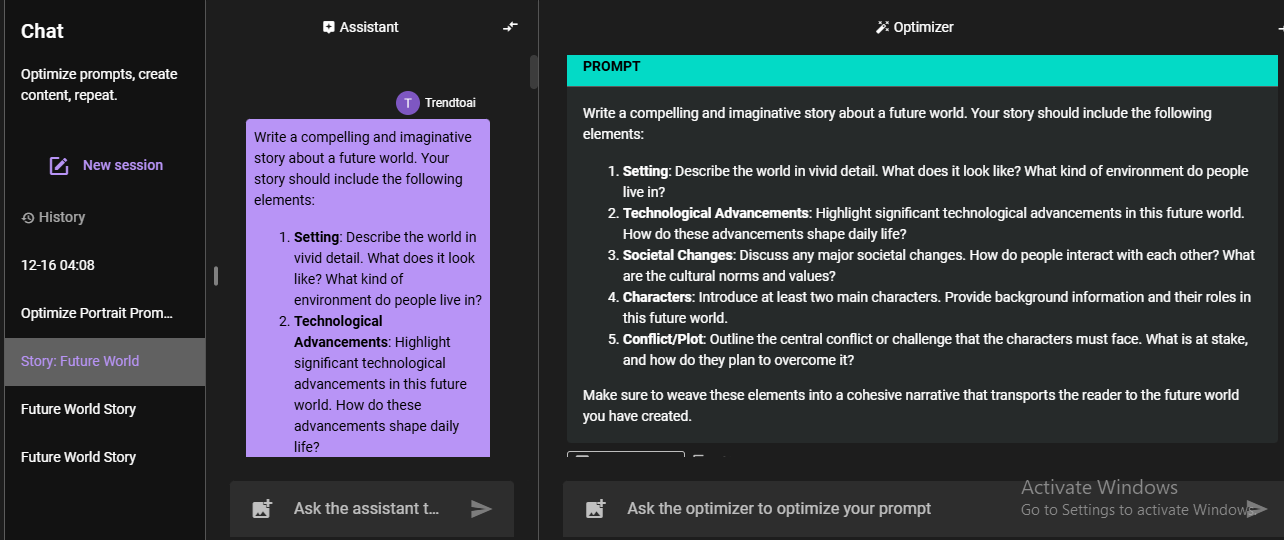
Conclusion
Prompt Perfect is the game in prompt generation. This tool not only helps you to make your tailored prompts but also allows you to optimize them for an advanced model like SD-XL while providing you with interactive help. An artist, a writer, a marketer, or a research worker would surely love this and unlock their potential by helping them get the perfect prompts for getting started with AI.
With tools like PromptPerfect, navigating the world of AI becomes easier, more efficient, and incredibly rewarding. Enhance your experience with AI models by using PromptPerfect and integrating this tool into your workflow.
Discovering Chatbots as Prompt Generators: ChatGPT, CoPilot, Gemini, and More
The chatbots running off the high-end AI models, such as the ChatGPT, CoPilot, and Gemini models, have transformed how people interact with technology today. They’re not limited to conversational capabilities and are very advanced at formulating, honing, and perfecting prompts into all sorts of applications from the creation of literature and generation of art to coding and solution-finding.
This paper expounds on how chatbots may function as a powerful tool for the prompt generation, complete with examples and use cases illustrating their capabilities.
How Chatbots Improve Prompt Generation
The emerging chatbots are designed to comprehend natural language inputs and generate responses that match the user’s intent. This is how they improve prompt generation.
1. Contextual Comprehension
It looks at the user’s input to determine just what it is that something specifically needs. Be that a story idea or maybe an instruction for an AI art generator, the bot adjusts its output to make it appropriate.
2. Flexibility
These platforms can alter the tone of a prompt, its length, or its complexity based on user discretion. For instance, it can ask for a business prompt as professional as the user desires or perhaps simpler for new users.
3. Refining Endlessly
The ability to iteratively enhance the quality of the output by giving feedback allows ease of perfecting the quality of the output till the point it matches the desired one.
4. Cross-Domain Expertise
Chatbots like ChatGPT, CoPilot, and Gemini are exposed to humongous data; they can create prompts for different fields, including art, literature, programming, or marketing.
Chatbots as Prompt Creators: Best Examples
ChatGPT as Creative Writing Prompts
OpenAI’s ChatGPT is very popular for its creativity in generating prompts. The writers and storytellers can use it to come up with creative ideas for their projects.
Example:
Generating a Story Idea Prompt
User Input:
“I need a prompt for a fantasy story about a hero discovering a hidden world.”
ChatGPT Response:
“In a tale set in a desert land a youthful explorer delves into the sandy depths and unearths a puzzling relic that triggers the emergence of a doorway, to an age old secret realm. In this world the ruler is firmly convinced that the explorer is the rebirth of their hero. However dissent brews among the inhabitants of this concealed domain and our protagonist must weave through a tapestry of mystery. Peril to unveil the truth behind their purpose, in this forgotten kingdom.”
This answer is detailed enough to prompt a writer but leaves enough to the imagination.
CoPilot for Programming Prompts
CoPilot revolves around user commands, much like understanding and responding contextually in the way ChatGPT and Gemini work. It is particularly robust with technical prompts, which places it at the top as an indispensable resource for software developers, engineers, and other tech-driven creators.
Example:
Creating a Data Analysis Prompt
User Input:
“I require a prompt for analyzing customer data trends using machine learning.”
CoPilot Response:
“Analyze customer purchase data for the last 12 months. Focus on variables such as the frequency of purchases, average spending per transaction, and product preferences. Use clustering algorithms to segment customers into distinct groups based on their behavior. Visualize the results with heatmaps and scatterplots to emphasize key insights that will help business decision-makers.”
This answer is concise and practical, suggesting exactly what to do for workers in data analysis.
Gemini for Diversified Prompt Generation
Gemini is an AI by Google that combines the strengths of conversational AI and its large-scale language modeling capacity. It is created specifically to produce high-quality prompts about diverse domains.
Given Example:
Create an Art Prompt Using AI
Input by User:
“Prepare a prompt for the artwork of a futuristic city against sunset.”
Gemini :
“Imagine an urban landscape in the city of the future, where great, shimmering skyscrapers composed of glass and metal reflect the neon glow all over it, as a sunset lights the orange and purple hues across the horizon that it casts on the buildings. On the foreground, zipping flying cars go through the air as one dressed in attires from the future strolls by on sleek, elevated walkways.”
This description can be used directly on tools like Stable Diffusion or MidJourney to create breathtaking AI art.
Major Characteristics of Chatbots in Prompt Generation
1. Natural Language Processing (NLP)
Chatbots utilize sophisticated NLP algorithms that interpret the input from the user for creating prompts according to the required specification. The feature of the chatbot ensures users describe their needs in the same language they use without concern for technical jargon.
2. Customization
The users can even specify the style, tone, or focus of the prompt. For example, a user may request to have a formal prompt so that he can write something on business matters or have a casual one for social media posting.
3. Multi-Domain Expertise
Chatbots can generate prompts related to stories art programming and marketing. It makes them so useful to professionals and hobbyists as well.
4. Iterative Improvement
Users can provide feedback on the generated prompts, which would improve and enhance them, as the chatbot uses such an iterative process to deliver the final output meeting the expectations of the user.
Prompt Generation for Coding: Simplified Approach
AI-powered tools like ChatGPT, Copilot, and others make coding faster and more accessible by generating functional code snippets based on natural language descriptions. These tools can understand user needs and produce code for various languages, including HTML, Python, CSS, and Java. This process reduces the effort required for repetitive tasks, enabling developers to focus on more complex challenges.
For example:
Consider a prompt like:
“Write a Python function that computes the factorial of a number.”
The AI might respond with:
def factorial(n):
if n == 0 or n == 1:
return 1
else:
return n * factorial(n – 1)print(factorial(5)) # Output: 120
HTML Prompt Generation with Practical Example
HTML forms the structure of web pages, and AI tools simplify creating templates by converting plain-language prompts into functional code. For example, with a request like:
“Create an HTML page for a simple blog with a header, a main content section, and a footer,” the AI might give
<!DOCTYPE html>
<html lang=”en”> <head> <meta charset=”UTF-8″>
<meta name=”viewport” content=”width=device-width, initial-scale=1.0″>
<title>Simple Blog</title> </head> <body> <header> <h1>Welcome to My Blog</h1>
</header> <main> <article> <h2>First Post</h2> <p>This is the content of the first blog post.</p>
</article> </main> <footer> <p>© 2024 My Blog</p>
</footer> </body></html>
Conclusion
From creative idea generation to art prompts to solving coding problems, Chatbots like ChatGPT, CoPilot, and Gemini have been a revolution in the creation and use of prompts. It combines contextual understanding, adaptability, and multi-domain expertise to enable users to better results using AI tools.
With the progress of AI technology, on the rise; chatbots are evolving to provide services and improved prompts across various fields like artistry, education, and caption generation among others This integration of chatbots into your daily routine could boost your efficiency and imagination while paving the way, for fresh ideas and accomplishments.
How to Create A Perfect Prompt
Creating a perfect prompt is essential when working with AI tools, as it ensures the output matches your expectations. Whether you’re using an AI art prompts free generator or working with a ChatGPT prompt generator, understanding how to create effective prompts is crucial for success. These tools enable users to generate high-quality content by providing specific instructions and refining the AI’s output.
For instance, if you’re using the prompt optimizer prompt, you can enhance the prompt to make it more focused and precise. This refinement is particularly helpful when you need specific results, like how to prompt AI to have specific text in image generation. Such detailed instructions guide the AI to produce content aligned with your needs.
The future of AI prompts is incredibly promising, as the ability to generate more tailored and creative prompts evolves. Tools like the writing prompt generator or art prompt generator offer an intuitive way to generate prompts, whether you’re interested in drawing, writing, or exploring new concepts. A great example is the AI character concept art prompt styles, which can help create unique visual representations based on specific details you provide.
For those working on narratives or stories, a system writing prompt for AI narrative storytelling can enhance storytelling projects. Whether you want to create a random art prompt generator or a prompt for generating a song, AI tools give users a creative edge. Also, with a story prompt generator, you can create new and exciting storylines for projects or interactive content.
Additionally, AI tools are becoming more advanced in various fields. For instance, using prompt engineering for Python code generation helps craft the perfect code by providing AI with clear instructions. Whether you’re generating prompts for educational purposes, such as studying with chat GPT ideas, or creating specific outputs like the Greek mythology writing prompts generator, AI prompts are essential to guide the process.
In conclusion, mastering how to make good prompts for AI image generators, text-based projects, or coding tasks is the key to unlocking AI’s full potential. As tools continue to evolve, they offer even greater possibilities for creativity and productivity. By understanding How to Create A Perfect Prompt, you can significantly improve the quality and accuracy of the output from AI systems, making your projects more efficient and effective.
The Future of Prompt Generation: Unlocking AI’s Full Potential
The speed at which the generation of prompts is changing, building the interactions of the future between human and AI systems progress in AI continues prompting a shift from simple commands towards dynamic instructions, making an effective link between human creativity and machine intelligence. Precision will improve and awareness of context enhanced as AI develops and transforms applications in various sectors.
Multimodal integration with capabilities is another development. Future prompt-generation tools will, no doubt, combine text and images but also voice inputs into rich outputs that are context-aware. Here, a user can imagine sketching a rough outline of a design while describing his or her idea verbally, where an AI system will give a high-quality, professional version of the design within seconds. This combination of modalities will therefore open up possibilities for intuitive and inclusive interaction, giving AI tools to the most unskilled but needy population.
Another promising avenue is real-time optimization with adaptive learning. Future AI systems will analyze user preferences, tone, and objectives in real time to create hyper-personalized prompts. For instance, content creators will be given suggestions that fit their unique writing style, while developers will see optimized code snippets that align with their coding standards. This adaptability will reduce the learning curve of using AI tools and improve overall productivity.

The future also holds cooperative AI assistants that can create chain-of-thought prompts. These assistants will allow users to define complex tasks with step-by-step guidance during a problem-solving procedure. The AI may facilitate the user with step-by-step guidance from brain-storming ideas to how to get finer output from this creative work; it shall enable people to achieve results with the kind that seemed unimaginable earlier except with certain specialized skills and knowledge.
Moreover, responsible and ethical prompt generation will become a foundation of AI development. Advanced tools will be designed to detect and mitigate biases, ensuring that the generated content aligns with the ethical guidelines and promotes inclusivity. Such measures will reinforce trust in AI systems, paving the way for broader adoption in sensitive fields like education, healthcare, and law.
The future of prompt generation transcends just generating better commands; it is changing the basis of how humans and machines collaborate. Advanced contextual understanding, personalization, and especially ethics prompt generations to revolutionize the digital stage in terms of creativity, productivity, and solving problems effectively.
By learning How to Create A Perfect Prompt, you can significantly improve the quality of the output from AI systems.
Author’s Insight
Sharjeel Jadoon is the visionary behind TrendtoAI, a website that is dedicated to making artificial intelligence accessible and understandable to everyone.
He sheds light on clear, practical content and strives to bridge the complex AI tools with the everyday user.
This passion for innovation goes hand in hand with empowering others through knowledge. Read more…


